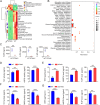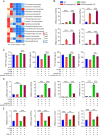STING exerts antiviral innate immune response by activating pentose phosphate pathway
- PMID: 39695767
- PMCID: PMC11656958
- DOI: 10.1186/s12964-024-01983-2
STING exerts antiviral innate immune response by activating pentose phosphate pathway
Abstract
Background: The innate immune system serves as the host's first line of defense against invading pathogens. Stimulator of interferon genes (STING) is a key component of this system, yet its relationship with glucose metabolism, particularly in antiviral immunity, remains underexplored.
Methods: Metabolomics analysis was used for detecting metabolic alterations in spleens from STING knockout (KO) and wild-type (WT) mice. Co-immunoprecipitation was employed for determining ubiquitination of TKT. Mass spectrometry was used for detecting interaction proteins of STING. Enzyme activity kits were used for detecting the activities of TKT and G6PD.
Results: In this study, we demonstrate that herpes simplex virus (HSV) infection activates the pentose phosphate pathway (PPP) in host cells, thereby initiating an antiviral immune response. Using STING-manipulated cells and systemic knockout mice, we show that STING positively regulates PPP, which, in turn, limits HSV infection. Inhibition of the PPP significantly reduced the production of antiviral immune factors and dampened STING-induced innate immune responses. Mechanistically, we discovered that STING interacts with transketolase (TKT), a key enzyme in the non-oxidative branch of the PPP, and reduces its ubiquitination via the E3 ubiquitin ligase UBE3A, stabilizing TKT. Silencing TKT or inhibiting its activity with oxythiamine diminished antiviral immune factor production.
Conclusion: Our findings reveal that the PPP plays a synergistic role in generating antiviral immune factors during viral infection and suggest that PPP activation could serve as an adjunct strategy for antiviral therapy.
Keywords: Antiviral immune response; Inflammatory factors; PPP; STING; Transketolase.
© 2024. The Author(s).
Conflict of interest statement
Declarations. Ethics approval and consent to participate: Protocols for animal usage were approved by the institutional animal care and use committee (IACUC) at Henan University, China. All animal experiments were conducted on the basis of the institutional guidelines, and were approved by the Laboratory Animal Center of Henan University. Consent for publication: All authors consent to submit and publish this article. Competing interests: The authors declare no competing interests.
Figures







Similar articles
-
RNF39 facilitates antiviral immune responses by promoting K63-linked ubiquitination of STING.Int Immunopharmacol. 2024 Dec 5;142(Pt A):113091. doi: 10.1016/j.intimp.2024.113091. Epub 2024 Sep 9. Int Immunopharmacol. 2024. PMID: 39255680
-
O-GlcNAc of STING mediates antiviral innate immunity.Cell Commun Signal. 2024 Mar 1;22(1):157. doi: 10.1186/s12964-024-01543-8. Cell Commun Signal. 2024. PMID: 38429625 Free PMC article.
-
The Role of REC8 in the Innate Immune Response to Viral Infection.J Virol. 2022 Mar 23;96(6):e0217521. doi: 10.1128/jvi.02175-21. Epub 2022 Feb 2. J Virol. 2022. PMID: 35107381 Free PMC article.
-
Glucose-6-phosphate dehydrogenase and transketolase: Key factors in breast cancer progression and therapy.Biomed Pharmacother. 2024 Jul;176:116935. doi: 10.1016/j.biopha.2024.116935. Epub 2024 Jun 14. Biomed Pharmacother. 2024. PMID: 38876050 Review.
-
HSV Replication: Triggering and Repressing STING Functionality.Viruses. 2023 Jan 13;15(1):226. doi: 10.3390/v15010226. Viruses. 2023. PMID: 36680267 Free PMC article. Review.
Cited by
-
Cyclic GMP-AMP Synthase (cGAS) Deletion Promotes Less Prominent Inflammatory Macrophages and Sepsis Severity in Catheter-Induced Infection and LPS Injection Models.Int J Mol Sci. 2025 May 24;26(11):5069. doi: 10.3390/ijms26115069. Int J Mol Sci. 2025. PMID: 40507879 Free PMC article.
References
-
- Kupferschmidt K. Stem cells hint at how bats live with viruses. Science. 2023;379:746. - PubMed
MeSH terms
Substances
LinkOut - more resources
Full Text Sources
Research Materials
Miscellaneous

